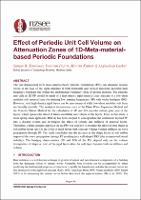Effect of Periodic Unit Cell Volume on Attenuation Zones of 1D-Meta-material based Periodic Foundations

Download
Date
2023-04-19Authors
Kumawat, Sanjay
Pujari, Sumiran
Kumar, Manish
Laskar, Arghadeep
Metadata
Show full item recordAbstract
The meta-material-based periodic foundations are being investigated by researchers for earthquake engineering applications due to their wave-filtering ability. The periodic foundations are characterized by frequency bandgaps, which restrict the propagation of waves with frequencies falling within the bandgap. Periodic foundations with low-range frequency bandgaps of 0-20Hz effectively mitigate devastating seismic disasters. The analytical formulations such as the Plane Wave Expansion method and the Transfer Matrix Method show that the low-frequency bandgap requires high-density and low shear modulus material in the rigid and the softer layer respectively, of periodic unit cells in the periodic foundations. The increase in the thickness of layers in the unit cell also helps in reducing the starting frequency of the bandgap. In addition, finite element analysis has shown that increase in plan size of the unit cells increases the attenuation capacity of the periodic foundations. The effect of the volume of individual layers in a unit cell of periodic foundations on its attenuation capacity has not been previously investigated. It is possible to reduce the overall weight of a unit cell by making it hollow and maintaining adequate depth for low-frequency bandgap. The present study adopts an analytical discrete model approach and finite element method to study the role of the rigid layer volume in the unit cell on the wave attenuation capacity of a periodic foundation with finite plan dimensions. The results would allow optimization of geometric parameters of periodic foundations with reference to the rigid layer to obtain desired starting frequency and the bandgaps.
